SB-Sat (SwiftBroadband for Satellite)
Services from Space Systems
SB-Sat (SwiftBroadband for Satellite) / BGAN (Broadband Global Area Network) Communication Services
SwiftBroadband is an existing terminal technology, a TCP/IP-based packet-switched service of Inmarsat, used to provide data links at speeds of up to 475 kbit/s per channel to commercial and military aircraft using the Inmarsat-4 constellation of three satellites, which provides global coverage, except for the polar regions, from geostationary orbit. The SwiftBroadband aeronautical mobile communication satellite service was initially introduced by Inmarsat in 2007 and became globally available in 2009. 1) 2) 3)
In 2008, Inmarsat Plc. of London, UK, completed its I-4 (Inmarsat 4th generation) constellation of 3 satellites (phased 120º in GEO) offering constant, near-global and real-time commercial communication services from LEO to the ground using its I-4 constellation as a communications relay. While a similar agency-internal service has been available via NASA’s TDRS system for years, this new Inmarsat data service will be available globally and commercially, and dramatically reduce data latency in retrieving payload and TT&C data from LEO spacecraft. 4) 5)
The great marketing success of the SwiftBroadband terminal technology introduction in the aircraft and ATS (Air Traffic Services) world, as well as in many Earth surface applications, generated in turn great desires by the operators of LEO (Low Earth Orbit) spacecraft.
The space agencies were of course recognizing this new service provision as a potential enabling technology that represents in effect a paradigm shift in the control and use of LEO spacecraft by providing near real-time, constant access to TT&C and payload data, utilizing communication via the Inmarsat series of satellites by exploiting the coverage provided by the I-4 constellation, which is not limited to covering the surface of the Earth, but extends significantly into space to develop and support a new type of service.
Currently, LEO satellites can in general only communicate with the ground during the ten minute period when they fly over a dedicated ground station. Hence, the satellites have to be designed to store their observation data until the satellite passes over a ground station and therefore real-time data cannot be provided to users. 6) 7)
In the near-future SB-SAT architecture, the LEO satellite hosts an SB-SAT terminal that communicates during its orbit with the Inmarsat-4 GEO satellite via an L-band ISL (Intersatellite Link). In this concept, the LEO terminal utilizes the existing Inmarsat-4 satellites and the BGAN ground network capabilities in a similar way to a ground or aeronautical BGAN terminal.
As a consequence of these new perspectives, ESA (European Space Agency) and the U.S. DARPA (Defense Advanced Research Projects Agency) approached Inmarsat with the request to modify the existing SwiftBroadband terminal service for use on small satellites in LEO. Both agencies are partially funding the new SB-Sat project which is expected to be completed by mid 2012 with the delivery of the terminal engineering qualification model and the BGAN network adaptations. The ESA support is provided through the ARTES (Advanced Research in Telecommunications Systems) program.
In the fall of 2010, a 'Teaming Agreement' for the provision of the spaceborne SB-SAT terminal and an associated service provision was signed by Inmarsat Plc. of London, BRE (Broad Reach Engineering) of Tempe, AZ, USA and Com Dev Ltd. Europe, UK. The SB-SAT consortium will jointly market the terminal and service to LEO satellite manufacturers and operators. The SB-SAT consortium contracts with DARPA and ESA were signed in August and in October 2010, respectively.
Inmarsat SwiftBroadband Terminal
SB-SAT is a communications terminal designed for LEO applications that provides a bi-directional communications link to the LEO from the ground via the Inmarsat 4th Generation GEO Communications Satellite Constellation and the Inmarsat BGAN Network. 8)
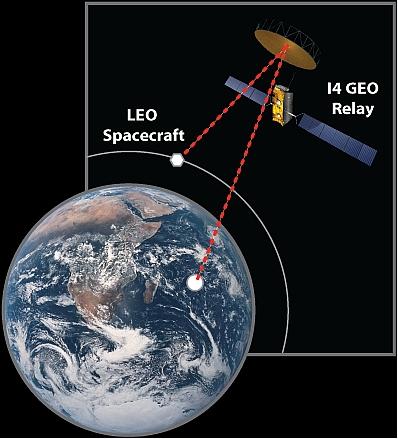
The architecture of the Inmarsat BGAN (Broadband Global Area Network) system for LEO spacecraft operations consists of three key elements:
1) the Inmarsat I-4 constellation of GEO satellites
2) the BGAN network and service infrastructure
3) the SB-SAT terminal hardware and software that is deployed on the LEO asset.
The SB-Sat spaceborne development is structured into two main stages: Ground prototype development & validation, engineering unit build. The staging provides an incremental development with gates for reviews between each stage (Ref. 7).
1) Stage 1: Ground prototype development & validation. This phase is the core of the development effort. It consists of the requirements development, architecture development, system design, and specification. This is then followed by an early implementation of the SB-SAT system in a prototype fashion using a breadboard unit of the UT, culminating in a set of ground tests in the lab and in a fixed ground environment with the Inmarsat test suites and the live Inmarsat BGAN network. The hardware developed is functionally identical to a flight implementation but utilizes a mix of commercial and space rated parts & technologies.
2) Stage 2: Engineering Unit build. This phase will take the work from phase 1 and implement it on an engineering unit terminal hardware. This includes the manufacture of an engineering unit terminal that is identical to a flight unit. This phase culminating in a set of regression ground tests in the lab and in a fixed ground environment with the Inmarsat test suites and the live Inmarsat BGAN network.
Key issues: For SB-SAT to operate within the existing Inmarsat BGAN network, precise (GPS based) knowledge of actual spacecraft dynamics is essential to pinpoint Inmarsat GEO assets, perform Doppler correction and correct return burst timing, allowing the new SB-SAT concept to coexist with the current user terminal population. Those functions are performed largely by the terminal. High-rate spotbeam handover (within the Inmarsat I-4 Satellite footprint) needs to be performed predictively in close coordination with the upgraded Inmarsat BGAN Core network..
Expected main benefits: The SB-SAT service will benefit from the access to facilities of the BGAN core network and global interconnect, which allow setting up and maintaining IP connection between the SB-SAT terminal serving the LEO spacecraft and the SB-SAT customer server anywhere around the globe.
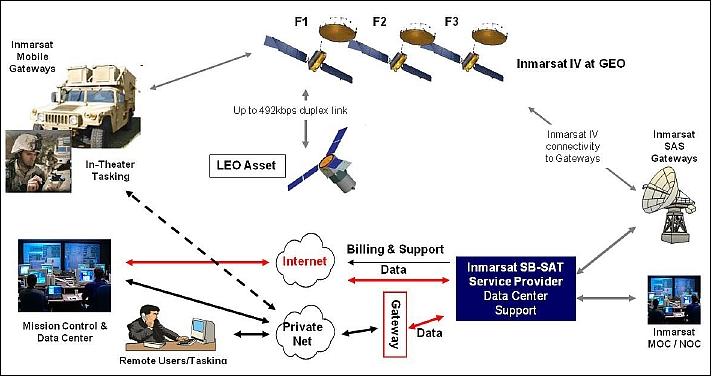
Service Coverage
The Inmarsat I-4 constellation is composed of 3 state-of-the-art telecommunications GEO satellites, located at 98º W, 25º E and 143.5º E. Each of the Inmarsat I-4 satellites supports 192 narrow spot beams for traffic channels, plus 19 wide spot beams and a global beam for system and signalling channels. The satellite generates 67 dBW of transmission power, and supports 600 channels of 200 kHz in the forward and return direction. By 2013 Inmarsat plans to have the AlphaSat spacecraft in GEO that will be added to the Inmarsat I-4 constellation and will provide a significant enhancement in terms of added capacity, service coverage and availability (Ref. 5).
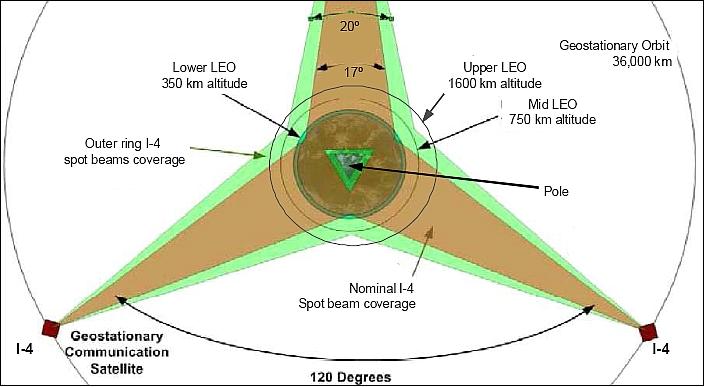
SB-SAT Terminal Description
A nominal SB-SAT terminal system consists of the transceiver, L-Band antennas, GPS subsystem, and antenna pointing mechanism. Fundamentally SB-SAT can be operated in different configurations, ranging from a transceiver only option with fixed low gain antenna to a system that includes a mechanically steered antenna, the related control electronics, and an internal GPS unit. At the core of all options is the BGAN Core Module which comprises the RF front-end, physical layer implementation (modem) and radio software (protocols, terminal control, and I/O). Since SB-SAT requires position and velocity information, an internal GPS unit is to be included unless a reliable external GPS source can be tightly coupled into the Core module, using the same interface definition of the internal GPS. The SB-SAT terminal design accommodates this configuration through a modular architecture that can be easily extended and modified to accommodate specific mission requirements while maintaining the integrity of the Core Module(Ref. 4).
The SB-SAT terminal includes the following elements:
• BGAN Modem Board: This module consists of the BGAN physical layer (modem) and the processing complex that manages the modem operation, hosts the BGAN protocol stacks, and provides SB-SAT system specific functionality and user interfaces. The physical layer is based on the design of an existing aeronautical based BGAN terminal and BGAN physical layer test systems designs ported to fully radiation hard technology. The implementation makes use of a combination of space flight proven DSPs (Digital Signal Processors) and FPGAs with core logic and software derived from existing terminal implementations which are modified to accommodate the specific hardware constraints and SB-SAT terminal environmental requirements.
The radio software is based on a mature BGAN protocol stack design, updated for SB-SAT terminal functionality, and ported onto a rad-hard Broad Reach Engineering BRE 440 SOC (System-On-A-Chip) PowerPC. This 200+MIPS CPU is required to host the BGAN protocol stack, drive the physical layer, and operate the SB-SAT application layer. The modem baseband functions are handled by a TI 320C6727 DSP that is being radiation hardened by a collaboration of AFRL and TI (Texas Instruments) through a process called “hardened by isolation.” Both the TI device and BRE PowerPC 440 are available now.
• RF Front End: The RF front end consists of the RF up/down-conversion hardware, LNA (Low Noise Amplifier), HPA (High Power Amplifier), diplexer, and linearizer hardware developed by COM DEV Europe specifically for space flight and BGAN applications. A unique feature of the COM DEV Europe solution is the proven linearizer/amplifier and diplexer/LNA (DLNA) which are adapted specifically for the BGAN system. COM DEV already supplies over 80 DLNAs per month for the ARINC class BGAN terminal.
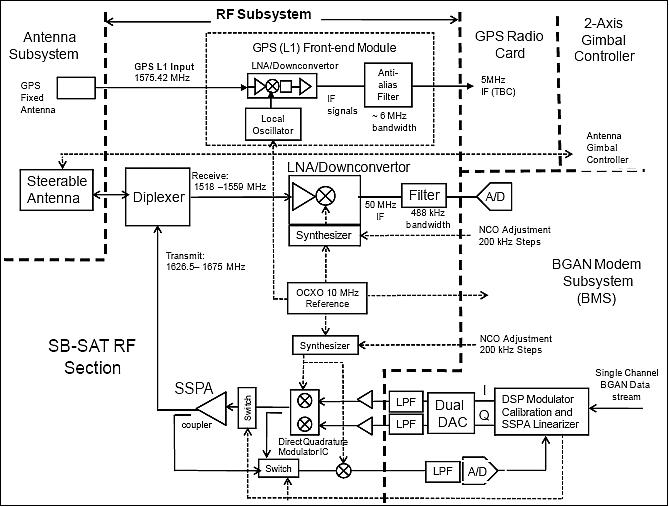
The RF subsystem consists of the following major components:
- Transmit/receive diplexer
- SB-SAT LNA/synthesizer-down-convertor with anti-aliasing filter
- Analog section of SDML (Self-calibrating Direct Modulator/Linearizer)/Synthesizer
- High efficiency GaN (Gallium Nitride) based SSPA (Solid-State Power Amplifier)
- GPS LNA/down-convertor/anti-aliasing filter.
The SB-SAT RF subsystem is divided into the Forward and Return sections. The Forward RF section receives the L-band signals from an Inmarsat IV/AlphaSat satellite anywhere within the frequency range 1518.0 to 1559.0 MHz. The received signal is then input to the diplexer filter which limits the receive noise bandwidth and suppresses any out-of-band signals or interference. The signal then passes to the L-band receiver which provides low noise amplification and frequency down conversion. A numerically controlled synthesizer down converts the wanted signal located anywhere in the 41 MHz receive passband in 200 kHz steps to a fixed intermediate frequency (IF) of about 50 MHz. The signal then passes through a narrowband anti-aliasing bandpass filter prior to digitizing.
The signal is bandpass sampled (under sampled) in the ADC providing the frequency conversion to low IF before digital frequency translation to complex baseband and filtering is used to isolate a single desired digitized version of the signal. This digital down conversion is part of the BGAN Modem Subsystem (BMS) which also provides Doppler frequency compensation. A highly stable reference signal from the OCXO (Oven Controlled Crystal Oscillator) is provided to the synthesizer.
In the Return direction, there are a number of possible approaches to the implementation of the RF subsystem. In order to minimize the DC power consumption of the SB-SAT UT (User Terminal), the baseline design will include a digital linearizer such that the SSPA can be operated efficiently while meeting the stringent linearity and spectral regrowth requirements of the BGAN system.
The linearizer design utilizes a DSP approach consisting of a feedback loop to sample the signal waveform distortion at the output of the SSPA. A downconverted and filtered version of the waveform is then digitized before being analyzed using proprietary DSP algorithms. The DSP then provides correction coefficients to the input I and Q data streams from the BGAN modem subsystem that reduce intermodulation and modulation regrowth levels so the amplifier can be operated closer to saturation and thus with better PAE (Power Added Efficiency). In addition to providing feedback to aid linearization, the feedback loop can be switched to sample the waveform at the output of the vector modulator prior to the SSPA input. Similar algorithms can be applied to this signal to determine imperfections in the I and Q paths to the direct modulator and provide corrections in amplitude, phase and DC offsets so that the carrier and lower sideband at the modulator output are suppressed sufficiently to comply with relevant BGAN requirements.
A frequency synthesizer under the control of the BMS provides tuning capability in 200 kHz steps so that the output signal can be transmitted anywhere within the transmit bands; 1626.5 to 1660.5 MHz or 1668.0 to 1675 MHz. Doppler frequency offsets to the transmitted signals are determined by the Doppler Compensation Processor (part of the BRE FPGA) and applied to the baseband I and Q signals. Any burst-by-burst re-tuning inside the assigned 200 kHz channel band is performed in the BMS (Baseband Modulator Section).
To achieve high efficiency, the SSPA will utilize Gallium Nitride power devices in place of conventional GaAs (Gallium Arsenide) devices. This takes advantage of the extensive improvements to these devices that have occurred over the past few years.
GPS receiver: The GPS receiver module is an embedded single frequency 12-Channel GPS receiver that is derived from the NASA/GSFC developed Navigator GPS which Broad Reach Engineering is porting to Broad Reach developed hardware for a US mission. Broad Reach has licensed the intellectual property rights to commercially market this receiver design. The receiver module is a single antenna implementation of the Navigator GPS with the existing RF front-end design being built into the BGAN L-band front-end by COM DEV to maximize the level of integration. A GPS input is required by the SB-SAT terminal for managing Inmarsat I-4 satellite spot beam handovers, and for correcting for Doppler and delay variations by integrating the GPS based range and range rate information into the BGAN signal acquisition and tracking functions. This tightly coupled system provides the required information and robustness to allow reliable BGAN signal compensation and tracking.
Motor driven system: This optional module provides the capability to drive stepper motors as commonly used on antenna gimbals on missions that require the higher data rate. The motor driver is implemented as a single 3U add-on card that is based on a BRE developed system successfully flown on the NASA Lunar Reconnaissance Orbiter. The motor driver is setup to support two 2-phase and 3-phase stepper motors that are commonly used to drive gimbal systems.
The chassis, DC/DC converters, and interconnects provide the housing for the various boards and RF front end. The design of this element builds on many similar chassis versions that BRE has developed and successfully deployed for various missions.
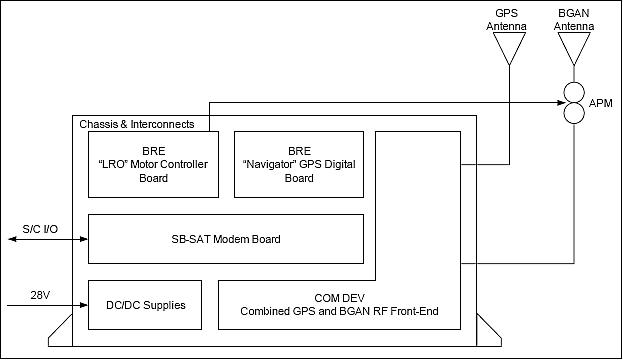
Terminal size, mass, power: The SB-SAT terminal has a volume of ~ 18 cm x 26 cm x 11 cm (not including antennas or gimbals) with a mass of 5 kg (not including antennas) and a power consumption of 45 W (including GPS when transmitting) and < 15 W in standby mode.
GPS and BGAN antennas: The GPS antenna is an L-band patch antenna with 3 dBic gain and approximately hemispherical 3 dB gain pattern. BRE has previously used and flown this antenna in conjunction with its IGOR GPS receiver. The BGAN combined transmit and receive antenna is typically a 3 x 3 array of L-band patches using similar technology as the GPS antenna. This 3 x 3 antenna provides approximately 14 dBic gain. For systems requiring higher data rates various APMs (Antenna Pointing Mechanisms) from a variety of supplier can be used. A typical APM mass is < 4 kg.
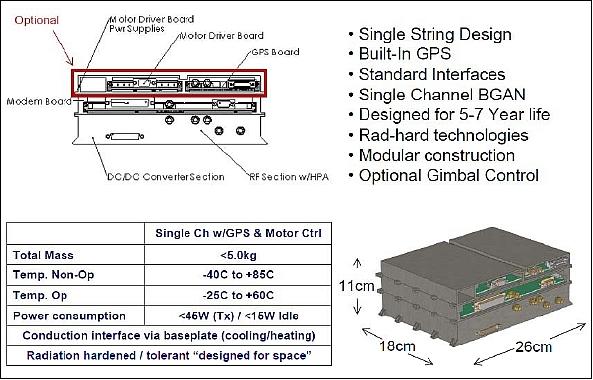
Coverage | Case | RTN (Return link) | FWD (Forward link) |
Nominal | Best case (center of beam) | 475 kbit/s | 464 kbit/s |
Worst case (edge of beam) | 332 kbit/s | 300 kbit/s | |
Extended | Worst case (edge of extended beam) | 258 kbit/s | 200 kbit/s |
Orbit inclination | 45º | 90º (polar) | ||
Link direction | RTN | FWD | RTN | FWD |
Sustainable average throughput (kbit/s) | 330.5 | 298 | 322 | 287 |
Sustainable volume/orbit (MB) | 229 | 206 | 208 | 185 |
Quality of service: SB-SAT will support the following types of TCP/IP services:
• Standard (background) IP service is expected to satisfy the service requirements of the majority of LEO satellite applications of SB-SAT, and therefore it is considered the normal mode of SB-SAT operation.
• Streaming IP service may be required in exceptional cases by an SB-SAT customer with unique requirements such as constant bit-rate, realtime video, or VoIP (Voice over IP).
The BGAN service supports multiple PDP contexts capability for delivering multiple parallel IP sessions, subject to available throughput.
All IP services are delivered at modem frame error rate of better than 10-3. Background IP frame errors are identified and eliminated using a retransmission mechanism built into the BGAN air interface.
End-to-end transmission latency: End-to-end transmission latencies differ between different IP service types:
• Background (standard) IP: Due to the dynamic nature of resource allocation for this IP service, latency will vary for different traffic profiles. Assuming an active data transfer is in progress, latency could vary between 500 ms and 1500 ms.
• Streaming IP: typically less than 500 ms.
Key advantages: SB-SAT provides a number of features that are unique compared to traditional commercially
available communications architectures as follows:
• Real-time communication from LEO to ground
• Global coverage
• Fairly high data rate, full-duplex communications link
• Existing network infrastructure
• No need for frequency allocations
• On-demand service, zero call-up delay
• Commercially available hardware & service
• Flexible service plans
• Competitive solution (terminal plus service) when compared with space to ground data relay alternatives.
Application to mission data collection: Through the Inmarsat system, analysis has shown that data rates of up to 475 kbit/s are possible. This opens up several new applications summarized below that can effectively change how LEO spacecraft can be used.
• Snapshot imaging - to determine value of more detailed observations. Of particular interest to EO data providers is the possibility to dramatically increase the efficiency of data production. In discussions with a major EO data provider up to 40% of daily images are ‘wasted’ due to the presence of cloud cover. There is a strong interest in being able to see low resolution images in real time and being able to task in real time to avoid wasted data capture (and the cost of transmitting the data to ground and around the associated ground network). They estimate that data capture could be increased to nearly 100% with no increase in cost.
• Real-time tasking of on-orbit assets from anywhere on the planet. The connectivity via Inmarsat will allow users in the field to task assets directly. Applications include military, NGO, relief agencies, and logistics activities.
• Instant access to ship AIS (Automatic Identification System). AIS signals are transmitted by every ship over 300 tons and there is a growing space-based capability to receive those signals and provide government bodies with information regarding ship movements on a global basis. The possibility to receive that data in real time and use that data to deploy coastguard or Special Forces to investigate suspicious vessels has major benefits.
• Rapid access to time critical data (such as Space Weather events) will allow the monitoring of critical events in real-time and will allow “now-casting” (vs forecasting) of potentially harmful events.
Service options: Several Types of Service offerings are being considered, including:
- Low data volume, high latency LEOs: This class may be TT&C only and/or provide limited mission data collection. Affordability is the driving constraint. Latency is not considered to be a driving issue.
- High Data volume, low latency LEOs: This class is dominated by time critical TT&C and/or mission data, Latency, of course, is important.
- TT&C only, low latency LEOs: This class is a subset of the High DATA, low latency class, with same assumptions on their drivers and cost base, however mission data is not latency critical and delivered via commercial ground based data relay (at S-band). SB-SAT is used to achieve real-time, always-on, on-demand, low latency TT&C.
The introduction of the SB-SAT terminal for potential customers is scheduled to be available in mid-2012. The novel service may revolutionize the way in which LEO spacecraft are being operated in the future as well as enable novel new applications that become possible from having practically a “24/7” access service to spacecraft data and telemetry.
References
1) SwiftBroadband: High-speed, IP-based voice and data,” URL: http://www.inmarsat.com/Downloads/English/Aero/SwiftBroadband_fact_sheet_EN.pdf?language=EN&textonly=False
2) SwiftBroadband Capabilities to Support Aeronautical Safety Services - WP1: Technical Description and Application to ATS,” Eurocontrol, TRS064/04, Edition 1.0, May 5, 2006, URL: http://www.eurocontrol.int/nexsat/gallery/content/public/SwiftBroadband%20Study/AeroBGAN-D1_v10.pdf
3) Peter B. de Selding, “ESA and DARPA To Study Use of Inmarsat-4 for Space Data Relay,” Space News, October 8, 2010, URL: http://www.spacenews.com/civil/101008-esa-darpa-study-inmarsat4-data-relay.html
4) R. Goldsmith, E. Trachtman, C. Lenz, C. McCormick, “24/7 Access to Leo Spacecraft TTC and Payload Data Using the INMARSAT BGAN Service,” Proceedings of the Symposium on Small Satellite Systems and Services (4S), Funchal, Madeira, Portugal, May 31-June 4, 2010
5) Christian Lenz, Chris McCormick, Rob Goldsmith, Eyal Trachtman, “Real-time, near global, low earth orbit communications using geostationary Inmarsat BGAN system as a relay,” Proceedings of the 24th Annual AIAA/USU Conference on Small Satellites, Logan, UT, USA, Aug. 9-12, 2010, SSC10-X-4
6) “ESA supports SB-SAT, a paradigm shift in controlling and operating LEO satellites,” ESA, Oct. 14, 2010, URL: http://telecom.esa.int/telecom/www/object/index.cfm?fobjectid=30555
7) “SB-Sat,” Oct. 4, 2010, http://telecom.esa.int/telecom/www/object/index.cfm?fobjectid=30532
8) “Inmarsat Swift-Broadband Terminal for Spacecraft,” URL: http://www.broadreachengineering.com/products/inmarsat-swift-broadband-terminal-for-spacecraft/
The information compiled and edited in this article was provided by Herbert J. Kramer from his documentation of: ”Observation of the Earth and Its Environment: Survey of Missions and Sensors” (Springer Verlag) as well as many other sources after the publication of the 4th edition in 2002. - Comments and corrections to this article are always welcome for further updates (eoportal@symbios.space).